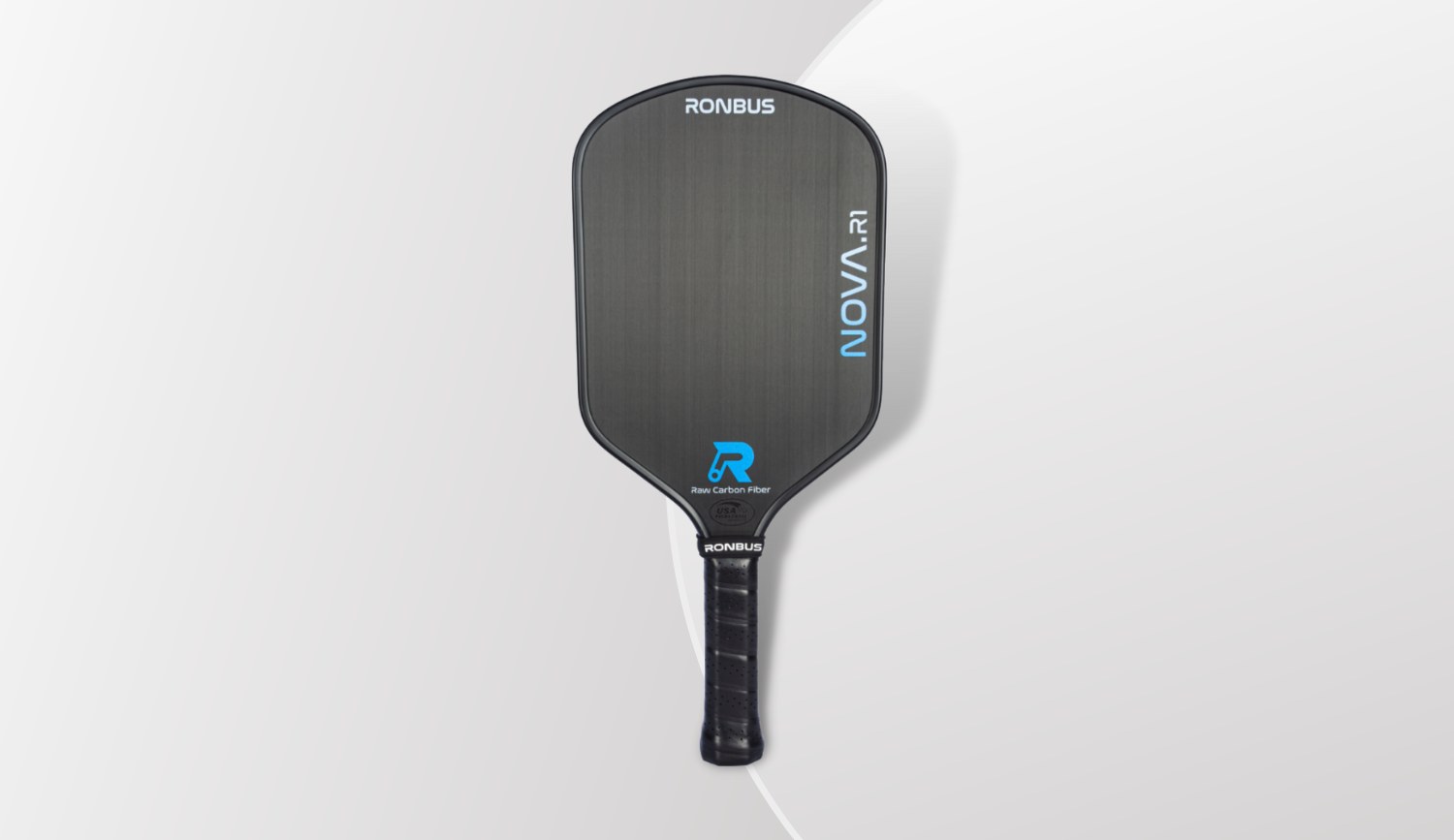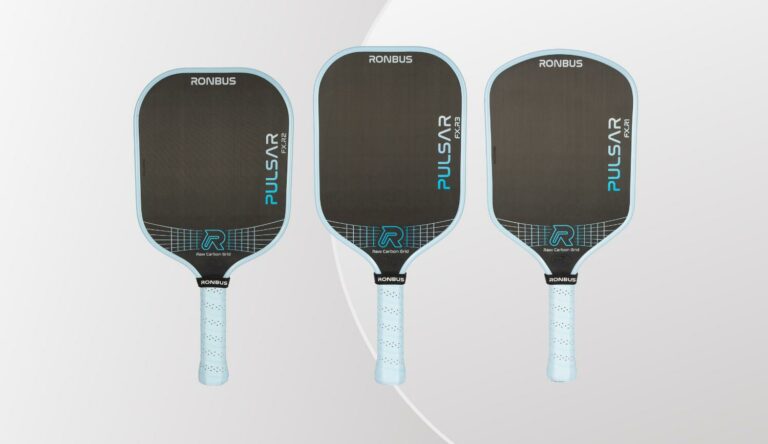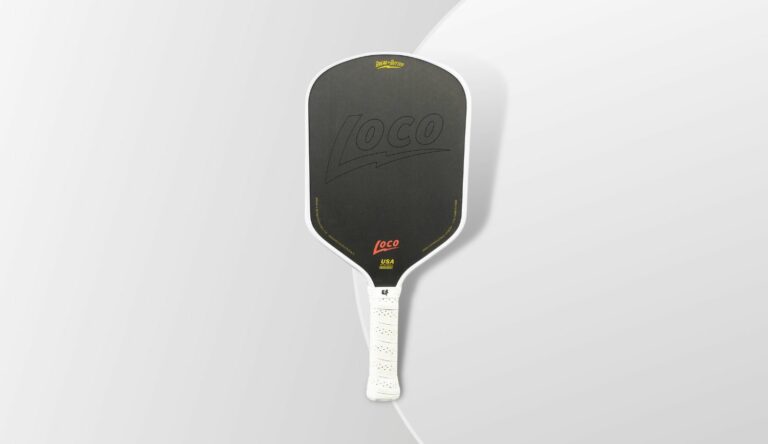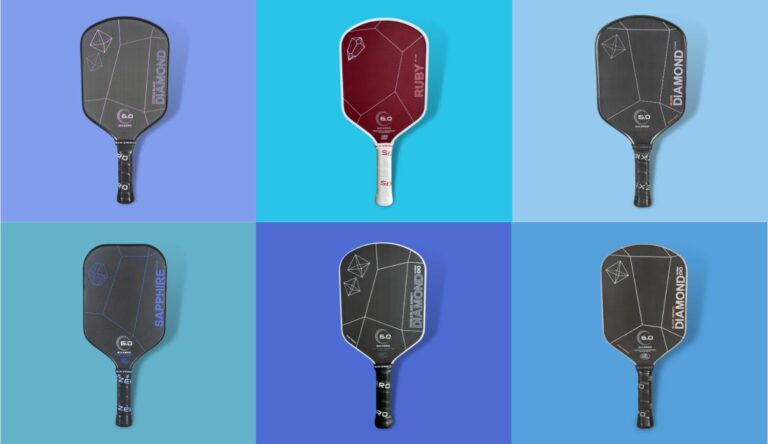Ronbus has just released their newest paddle line, the Nova. This is one of the biggest paddle drops this summer for those in the know. The Nova joins a growing lineup of paddles from this small but impressive pickleball manufacturer.
Dong Li (retired engineer & owner of Ronbus) is calling the Nova a “Gen. 3” thermoformed paddle due to its new innovations. You’ve likely already heard the term Gen. 2 (hot-molded thermoforming), and maybe even Gen. 1.5 (thermofoaming).
Ronbus’s new patent-pending Gen. 3 technology focuses on retaining the powerful characteristics of Gen. 2 thermoforming while addressing quality control issues that have plagued Gen. 2 paddles since their inception (core corruption, disbonding, delaminating, etc).
It’s exciting to see new proprietary methods meant to address core thermoforming issues. Ronbus’s thermoformed Pulsar paddle series has already made huge strides in this area, and the Nova is here to take the next step.
So, how does the R1 Nova perform? Was Ronbus able to address desired changes in their Gen. 3 production methods while retaining the essence of Gen. 2 thermoformed paddles?
Let’s dive in and take a look.
Note that this review is exclusively for the R1 Nova paddle shape. The R3 (elongated) shaped Nova was released on Oct. 31st 2023 and has its own review on this site.
Contents
R1 Nova Paddle Technical Specifications
- Price:
$180($160 with code DASHPB) - Shape: Hybrid
- Core thickness: 16mm
- Face: Raw Toray T700 Carbon Fiber Textured
- Average weight: 7.7 oz
- Grip length: 5.5″
- Swing Weight: 115
- Grip size: 4.125″
- Core: high-performance polypropylene honeycomb
- Total length: 16.5″
- Width: 7.5″
- Warranty: 6 months for manufacturing defects
Ronbus R1 Nova Quick Summary
Update Oct. 31 2023: from here out the R1 Nova production has shifted the density and angle of its edge grid structure. This comes standard with the newly released R3 Nova and is meant to help the paddle perform with more touch of soft shots and more crisp power on drives.
The R1 Nova is an excellent all-court paddle that leans toward power. The R1 features a hybrid shape that’s slightly longer than standard-shaped paddles and has a curved top that flares out. The R1 Nova has the enhanced power of thermoforming, strong control capabilities, high spin numbers, and unmatched durability in the thermoforming space.
The Nova features technological innovations that improve upon Ronbus’s already impressive thermoformed paddle line, the Pulsar series. The engineering involved in Ronbus’s Gen. 3 manufacturing process centers around a patent-pending “Edge Grid Technology” that increases both durability and performance.
Overall, the Nova delivers on its main premise. It significantly improves durability without sacrificing prized thermoformed performance characteristics. I found the Nova to perform just as well as my Gen. 2 R1 Pulsar paddle, which is among my all-time favorite pickleball paddles.
While the Nova is excellent out of the box, I did choose to add weight to my Nova paddle to achieve the performance that I like. More on that later.
On Gen. 3 Thermoforming
Since this is new tech being released in the Nova, I’ll briefly cover what it entails and how it differs from original thermoforming processes.
Thermoforming involves adding a great deal of heat and pressure to a paddle during manufacturing. The paddle edge is sealed and the paddle is placed in a high-temp oven for hours. Ronbus diagnosed durability issues with this process related to high-heat pressurized air bubbles being trapped inside the sealed-off paddle core which would lead to paddle malfunctions over time.
Issues have been common because paddle materials, such as honeycomb cores, typically have many slight imperfections due to how the material is cut, which leads to alignment issues. Because of this, hot air from thermoforming gets trapped in thee tiny spaces between the honeycomb core and the paddle’s face sheet, eventually leading to issues.
Ronbus addressed this by changing the way the paddle edges are sealed. Instead of entirely sealing the edge foam around the perimeter with a carbon fiber seam, Ronbus chose to instead use a permeable carbon fiber grid to seal the foam around the perimeter. This way, the hot air is able to release post-thermoforming and not cause the paddle core and face to degrade. The end result is a paddle with slight permeability along the edges. This allows it to breathe consistently, making it more resilient to temperature changes throughout its life.
It may seem simple, but a proper fix like this has proven elusive. This small innovation can potentially save thousands of thermoformed paddles from meeting untimely ends due to faulty design.
Feel
Like all Ronbus paddles, the R1 Nova feels excellent in hand. Many paddles feel flimsy or otherwise cheap, but I’ve found Ronbus paddles to be like an extension of my hand.
One of the first noticeable distinctions of the Nova is its weight. The paddle is lighter and far less head-heavy than other thermoformed paddles due to the Gen. 3 permeable edge grid. My Nova came in at a lightweight 7.7 oz and doesn’t feel hollow or cheap, just lighter than what you might typically expect from a thermoformed paddle.
The paddle is well-balanced and not head-heavy. I don’t have a method to test the balance point, but I hold a lot of paddles running this website, and the Nova felt just right.
Like other Ronbus paddles, the handle length and circumference hit a sweet spot. The 5.5″ handle is long enough for two-handed backhands and gives good whip and leverage.
The octagonal shape of the handle and smaller 4.125″ circumference feel great in hand and is perfectly suited for players who possess smaller hands or prefer smaller grips. The 4.125″ size is also perfect for layering one or more overgrips to your liking.
Power
I was very curious to test the power output of the R1 Nova. I love power paddles, so, of course, I naturally gravitated toward the Gen. 2 thermoforming trend. The Nova’s new features and lightweight profile really intrigued me. Could a lightweight paddle that’s radically addressed durability issues still deliver the power I crave?
Overall, I found the power of the Nova to land in an ideal range and it should be able to deliver the right amount of power for almost every type of player. My serves, drives, overheads, counters, speed-ups, rolls, punch volleys, and putaways all felt potent and easy to put pace on with the Nova. I had zero complaints about the power, especially after playing with the Vatic Pro Prism Flash, which felt anemic by comparison (though an excellent control paddle).
The Nova doesn’t hit quite as hard as many of the original Gen. 2 paddles, but I found its power to be about the same as the newer (modified) releases of those paddles.
It seems that all thermoformed paddles have been getting slightly softer as they’ve released modifications to address durability issues. The new CRBN 1X and Legacy Pro come to mind. These paddles absolutely smashed when they first came out. But the newer released versions of these paddles are not quite as powerful. The R1 Nova hits comparably hard to these new released versions, and similarly to the Ronbus Pulsar and Six Zero Double Black Diamond.
The Nova definitely has more power than Gen. 1 and Gen 1.5 paddles, including the original Ronbus R1.16 and the Vatic Prism Flash. I definitely put the Nova in the thermoformed power category, but if you want your Nova to have truly equal power to other Gen. 2 thermoforms, you’ll want to weight it up to an equal weight. For example, I weighted my R1 Nova up to 9 oz and it hits comparably hard as my 9 oz July release (softer production) Six Zero Black Diamond Power paddle.
If you leave the Nova at stock weight under 8 oz, you’ll get an amount of power that’s bigger than a Gen. 1.5 paddle, but slightly less than a Gen. 2
Pop
The R1 Nova’s pop output feels slightly above average. It’s crisp and responsive on short strokes without being too animated. It felt very quick and punchy during hand battles and on fast counters and punch volleys.
Overall, the pop level of the Nova is on the mid-tier end of thermoformed paddles. There are a number of paddles with higher levels of pop, such as the Bread & Butter Filth, Six Zero Black Diamond, and (some) Legacy Pros, but the average player does not need that much pop and may find that the Nova has the perfect amount for them.
Control
I’ve been very happy with the control capabilities of the R1 Nova. The shape is great for maneuverability and its just soft enough as a thermoformed paddle to provide an ideal balance of responsiveness and touch.
I really enjoy my soft game with the Nova, especially after adding some weight to it via an overgrip and lead tape. It’s great for drops and resets. I felt great on my 3rd shot drops with the Nova.
The sweet spot on the Nova is excellent and on par with the Double Black Diamond. I liked it more than both my Ronbus Pulsar and original R1.16 paddles. The Pulsar is certainly close in sweet spot performance due to it also having edge foam. Both are stellar and very forgiving on off-center hits. I definitely liked the sweet spot of the Nova more than the new Selkirk 006 and Joola Perseus.
It doesn’t have the complete feather touch of a non-thermoformed paddle, but the Nova is surprisingly intuitive and manageable for the soft game. I love the responsiveness and precision for overall controlled play. That bit of extra power and pop really help in certain situations, too.
I do recommend adding some weight via lead tape and/or an overgrip to increase the stability of the Nova. At 7.7oz I didn’t feel like I could handle countering hard drives very well if I hit them off center. Some lead tape helped this tremendously.
Spin
The R1 Nova’s surface creates excellent spin. It has the same tightly woven raw Toray T-700 carbon fiber as the original R1.16 and Pulsar paddles.
At stock weight, the Nova felt to me like it had slightly less spin than some of my highest-spinning paddles, but the spin really showed up once I added weight to the paddle to get it up to 8.5oz.
The spin output of the Nova in the high-tier range, high enough for it to land on my list of the best pickleball paddles for spin. It feels a little bit less spin output than my other Ronbus paddles, but on par with some Vatic Pros and more spin performance than the new Joola Perseus and Selkirk 006.
But, ultimately, I’m splitting hairs here. The Nova has high-tier spin that allows me to effortlessly shape shots with good form. Slices and cuts rip off my paddle and bounce like crazy. Paddles with this much spin really give an opportunity for getting an edge against high-level players. I can really make good players work hard to get their 3rd shots drops in against my slice and cut returns using the Nova.
All in all, the Nova is very spin friendly and you’ll be able to rip off some wins while you rip ball dust off with your new paddle.
Hand speed
With its low stock weight and curved aerodynamic shape, the Nova is one of the quicker thermoformed paddles you can play with. Ronbus officially labels the swing weight of the R1 Nova at 115, which places it on the quicker end for hand speed.
Before I added weight to my Nova I tested it side by side with my 14mm Vatic Pro Flash. Both felt very nimble and maneuverable. I love light thermoformed paddles like this for a certain kind of fast-paced play. The Vatic Pro was a bit quicker, but the difference was negligible and I had a ton of fun playing as quick as I could with both.
Now, I do recommend adding just a bit of weight to the Nova to give it more stability. This helps your counters be a bit more forgiving if you hit slightly off-center during a hand battle. .4 oz near the bottom of the throat should be enough to not affect hand speed much.
Durability
If you’ve read the review this far, you’ll already know that this is where the Nova shines. It’s an excellent paddle all around, but Ronbus’s accomplishments in the area of durability are what set this paddle apart from the pack.
Thermoformed paddles have had issues since their inception. The high temps combiend with a sealed in paddle face caused issues that took a long time to address and resolve. Every company that makes thermoformed paddles has introduced fixes from reducing heat exposure durations to adding more and different types of resins/glues.
These have all worked to varying degrees. But, ultimately, issues have continued to crop up, albeit to a lesser degree for some manufacturers. Ronbus, led by their engineer founder, has continued to push innovation and discovered an intelligence solution to durability issues.
They’ve tested their new designs extensively. One of Ronbus’s tests involves attaching the Nova to a swinging mechanized arm that repeatedly thrusts it into a rubber stopper at 150mph. They do this cycle for 10,000+ rotations and dissect the paddle to analyze potential damage. Ronbus decided to release their new tech when they found zero core crushing or other damage from this extensive testing process.
We still have to wait for real-world tests over the coming months, but everyone seems pretty confident in these fixes. Especially when Ronbus already has a good track record for addressing durability issues in their thermoformed Pulsar paddle line.
Value
The Nova is $160 after using discount code DASHPB at checkout. It’s more expensive than some other thermoformed paddles, such as the Vatic Pro V7 and Vatic Pro Flash. But the performance and durability combination in the Nova makes it well worth the price tag.
Even with manufacturing improvements across the industry, no other thermoformed paddle is going to give you the peace of mind as the Nova when it comes to durability.
Anyone who’s a Gen. 2 paddle enthusiast will tell you that running into delamination, core crush, and disbonding is really a drag. Many first time buyers have run into durability issues within weeks, as well.
This is the first time that I can recommend a thermoformed paddle that instills this much confidence in its ability to avoid these sorts of issues, which really skyrockets its value in my mind.
Plus, the Nova’s performance is just better than many paddles over $200. Ronbus paddles are simply excellent performers. So the value is there across the board.
Should you buy the Ronbus R1 Nova?
The Nova isn’t a mind-blowing jump in paddle technology, but it does represent the incremental type of innovation that we enthusiasts have wanted to see in the market. I’ve been waiting for this paddle since I heard rumors about it for over six months now. It’s finally here, and I’m entirely pleased with it.
If you’re interested in a durable thermoformed paddle that’s going to deliver on performance and longevity, then pick up a Nova for yourself and use code DASHPB to save $20 on your order.
If you’re upgrading from a non-thermoformed paddle, be ready for the Nova to give you an edge that you didn’t know you needed. If it’s your first Ronbus paddle, I think you’ll really love what you get. And you can feel good supporting a small business that’s actively advancing pickleball paddle technology and bringing the sport forward for all of us.
Remember that Ronbus will be releasing the Nova in another shape in late September. This will be the elongated R3 shape. I typically recommend the hybrid R1 shape to most players, but if you’re interested in the elongated-shaped R3 Nova, check back here, as I will have a review posted for that paddle on release day.







4 thoughts on “Ronbus R1 Nova Paddle Review (Feel, Power, Control, Spin)”
Add Lead tape to paddle
How much
Best place to put
Hi, Phyllis. I put 1gram per inch tape on each side from the top of the handle/bottom of the throat up the flat side almost until the top curvature. This brought my Nova to around 9 oz.
Is the tape on the handle itself or the lower sides?
Lower sides